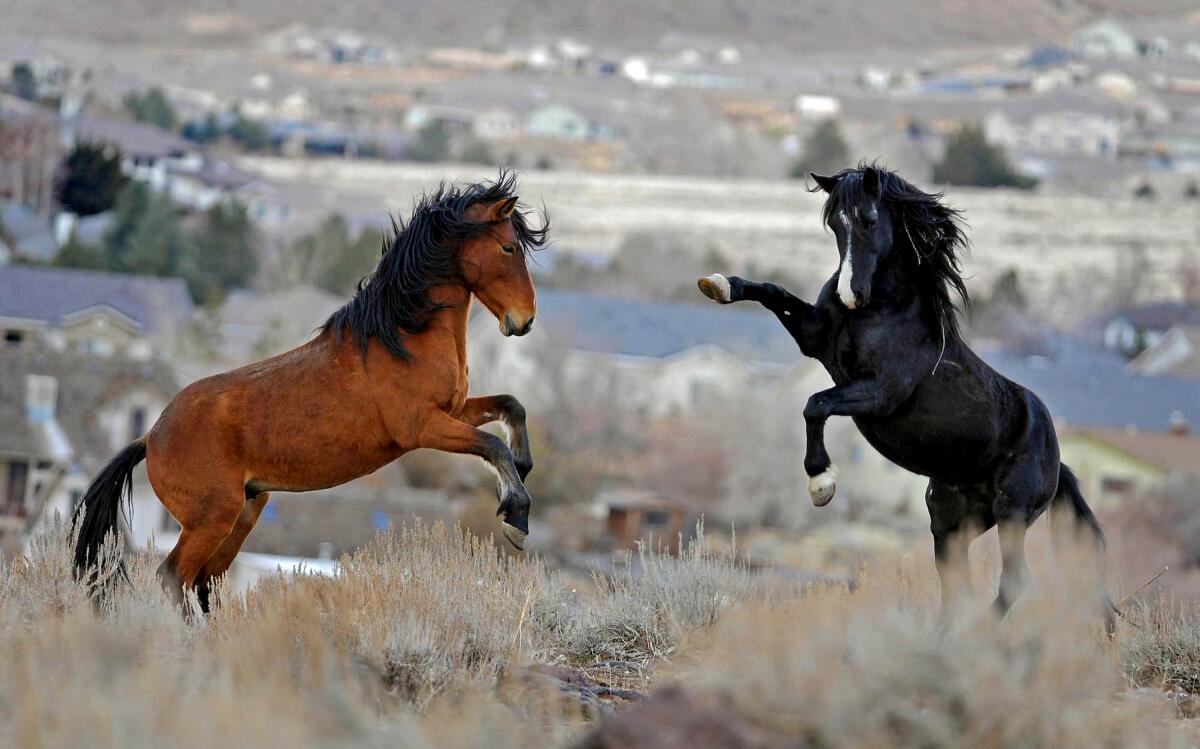Op-Ed: Let wild horses do their part to save the West

- Share via
America’s wild horses are in crisis. Throughout the West, they are being rounded up and kept by the government in what amount to prisons before being sterilized or auctioned off — some to owners who will treasure them, but others to middlemen who will ship these beautiful animals to the slaughterhouses of Canada and Mexico.
It is a horrific crime against a noble species, and few Americans even know it is happening.
At the same time, we are watching as our world dries out and burns up. Californians know better than anyone the cost we are paying for climate change. Furnace-like temperatures. Deeper floods. Longer droughts. No one can doubt that we are at a moment of profound and scary change.
But what if we could take action on both these challenges at the same time? Because horses can once again come to the rescue of the human race, at least a little bit, and work as our allies in the war against global warming. It sounds crazy, but there’s good reason to think that wounds to our fragile ecosystem will heal more quickly if we allow modern wild horses to roam the West as equines once did thousands of years ago, returning to the role of a “keystone” species keeping nature in balance.
First, the facts.
The Bureau of Land Management, which is responsible for wild horses on federal lands, has rounded up about 50,000 and is warehousing them in government-funded pastures and other locations at a cost of $120 million so far. More than 79,000 horses and about 15,000 burros still roam freely on federal land in 10 states. The government believes 27,000 is the right number, based on a formula last revised in the 1980s, and so it intends to round up another 50,000 animals over the next 10 years.
The roundups aren’t pretty — with horses chased and terrified by helicopters and then corralled — and neither is what happens next, as many are auctioned off to owners who flip them for a quick profit. So why is the government doing this?
Cattle.
The cattle lobby is extraordinarily powerful, and it wants all that federal grassland for grazing. Hundreds of thousands of cattle roll across the landscape in monster herds that overgraze, damaging public land. Think of that the next time you order a porterhouse.
We need to let horses have their land back, or at least let them share it with cattle. These are mega-herbivores — plant eaters that weigh more than 1,000 pounds. North America had plentiful mega-herbivores back in the Pleistocene, including not only Equus species and bison but also mammoths and mastodons. Today, wild horses tend to be the dominant mammal wherever they are and act as sort of ecosystem engineers, creating spaces and opportunities for other species and plants to play their roles in nature.
Unlike cattle, which tear up the roots of grass and clumps of dirt, leaving arid wastelands, horses chomp grass from the top, leaving it to grow back quickly. And they have single-track digestive systems, meaning that grass and other foodstuffs pass quickly through their systems without being as fully digested, as happens in cattle and other ruminants. Horse dung is therefore a key spreader of seeds.
Also unlike cattle, horses eat saplings, preventing trees and forests from taking over our grasslands. Although forests take carbon out of the atmosphere, trees eventually burn and release it back into the air. Grasses lock CO2 in their root systems.
Horses are also “dowsers,” who can smell underground water near the surface and dig down to it with their hooves, creating wells at which other, smaller species can drink. Those animals both consume even smaller species and are prey to larger predators.
There’s not a hard choice to be made here. The cattle industry has tried to push out horses, but they can occupy the same land as cattle. Horses can scale foothills and rocky outcroppings and easily ford streams. Cattle would struggle to do the same. Given freedom, each species will find its niche.
Preserving grasses that take carbon out of circulation. Keeping vegetation healthy. Digging wells. These are all little ways that horses can help fight climate change. Why not let them?
Ending the roundups would also save taxpayers millions of dollars. Think how that money could be better spent on our environment.
Repopulating the American West with horses is just one aspect of a much larger movement called “rewilding.” The basic idea is to set aside large areas and populate them with species that can make a go of it there — with little or no human involvement. This could include not only mega-herbivores but also the big predators that would keep their populations in check.
In Europe, rewilders use abandoned agricultural lands. Humans can no longer make a living there, but the animals can. The results are healthier environments where native and domestic animals, both predators and prey, can thrive.
The U.S. government needs to change the way it is treating horses, a species that has helped humans for millenniums and stands ready to do so again. We just have to let them.
Manda Kalimian is the president and founder of the Cana Foundation, which supports rewilding in the American West. Her book “Born to Rewild” comes out Oct. 1.
More to Read
A cure for the common opinion
Get thought-provoking perspectives with our weekly newsletter.
You may occasionally receive promotional content from the Los Angeles Times.










